Brazing s a Means to Make a Part.
So far, we’ve been talking about brazing as a way of joining two or more metals into a permanent assembly. And we’ve limited our discussion to the situations where you have a metal assembly in mind from the outset, from initial product concept through finished piece. Now let’s discuss brazing from a very different point of view. Think about the parts your company fabricates, and consider where any of those parts now made as monolithic units, might not be made more efficiently as brazed assemblies. Consider this real-life story…
A company was fabricating thousands of small, closed-end metal cylinders. The part looked like this:

For years the cylinders were machined out of solid bar stock, with considerable labor required to drill and bore the blind holes. Finally, someone suggested that the cylinder was actually two parts–bar stock cut-offs brazed into lengths of stock tubing:

The assembly is a lot less expensive to make than the machined part and it works just as well.
Think Brazing at the beginning.
The time to consider brazing is at the beginning, when you’re first planning or designing and metal component. Ask yourself if the part should be made as a single unit, or if it can better be made as an assembly of simple components. The “assembly” approach may help you eliminate expensive casting, forging and machining operations. It may save materials. It may enable you to use low-cost stock forms–sheet, tube, rod, stampings or extrusions. It will almost invariably be lighter in weight than the monolithic part, and will probably work better as the metals in the assembly can be selected to match their functions. Let’s look at some typical metal “parts.” First we’ll see how they’re made be conventional casting, forging and machining methods. And then we’ll see how the could be made better and more economically as brazed assemblies.
From casting to sheet metal.
You’re designing a housing, with threaded holes in the flange. You could make it as a casting. But consider instead making it as a brazed assembly, joining bar stock sections to a sheet metal deep draw:
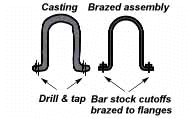
The brazed assembly works just as well as the casting. And it’s a lot cheaper to make, because you’re putting the thickness only where you really need it–in the flange and not the shell. You save weight, materials and labor.
From forging to brazing.
You’re planning a part–a hardened cam on a steel camshaft. Should you machine the unit out of a solid bar of tool steel? That’s a lot of lathe chips. Perhaps forge the piece, and then finish-machine it?

Still a lot work. After hardening, the cam has to be drawn and the shaft ends annealed. How about making the cam and shaft separately and then join them mechanically as an assembly?

You’re on the right track. By substituting cold rolled for tool steel in the shaft, you’re saving on material cost. But machining is still somewhat involved, and locking device, such as a set screw, is subject to loosening under vibration. Now try the “assembly” approach again, but this time use a brazed joint instead of a mechanical one.

Simplest of all. No keyway, no key, no set screw. Minimum material, minimum labor and a strong, permanent, vibration-proof bond,
The awkward elbow.
Extensions or projections on metal parts require excessive material (expensive!), and then a lot of work to machine away the unwanted metal (twice as expensive!). Consider what happens when you make an elbow shaped part from solid stock…
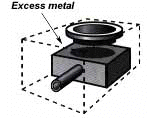
You’re paying for metal you don’t want, and the labor of getting rid of it. There’s an easier way. Make the “part” as a brazed assembly, joining together standard tubing and bar stock components:
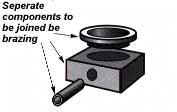
The assembly will be just as strong as the machined part. And you’ll save materials, labor and weight. (The more awkward and complex the extension, the more you’ll save.)
From hard to easy.
You have to design a leak-tight component, with complex configuration. You can plan it as a cored casting…
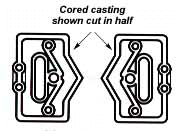
It will be lead-tight, but a cored casting is an expensive one. An open casting is a lot cheaper to make. So why not make it that way?
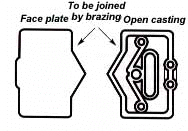
By using brazing, you’ve replaced the complex cored casting with a simple open casting and a metal stamping. Machining is easier, and brazing’s capillary action assures you of a leak-tight bond.
From casting to stock parts.
Let’s say you’re designing a base plate with a threaded coupling. You can make it in one piece as a casting…
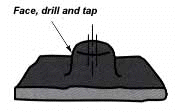
Material cost is low, but material choice is limited. Weight is excessive, machining extensive, and the finished part may be weak and brittle. Consider making the “part” as a brazed assembly of stock elements…
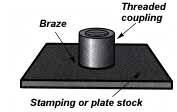
Machining is minimal–the base plate is a stamping and the coupling a screw machine part. Weight is down to the bone, too, because the thickness is only where it’s needed, in the treaded coupling. Material can be matched to function. And the assembly will undoubtedly be stronger than the casting.
Two metals are better than one.
The ability of brazing to join dissimilar metals is helpful in many applications, but in some instances it’s quite critical. A classic example is the carbide metal-cutting tool. The tool could be made entirely of carbide. But carbide is expensive. What’s more, though carbide is fine for the cutting tip, you don’t really want to use it for the tool shank. It’s too hard and brittle to withstand shock. Brazing solve the problem…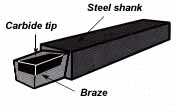
By brazing, you’ve reduced material cost–obviously. But even more–you’re now using metals perfectly suited to their functions. Hard carbide at the cutting edge, and shock-resistant tool steel for the shank.
Freedom for the designer.
We started this section with a question: “When do you think brazing?” And we’ve indicated, through just a few of the many possible examples, that you think brazing at the beginning–at the design stage. The fact is–brazing liberates the designer. It enables him to design for function, for light weight, for selective use of metals, and for production economy, The designer who’s fully aware of the possibilities of brazing thinks less and less in terms of castings, forgings and parts machined from solid metal, He thinks more and more in terms of brazed assemblies, which combine plate or sheet stock, standard tubing and bar, stampings and screw machine parts, Assemblies based on the use of such elements are generally lighter in weight, less expensive to fabricate, and at least equal in performance to metal parts made as monolithic units.
Continue to Section 1 – Part 3, The Principles of Joint Design


[…] When Do You Think Brazing? […]